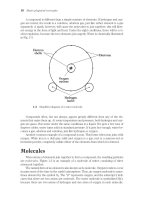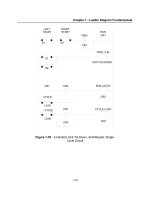Tài liệu Corrosion: Fundamentals, Testing, and Protection P2 docx
Bạn đang xem bản rút gọn của tài liệu. Xem và tải ngay bản đầy đủ của tài liệu tại đây (197.66 KB, 10 trang )
Fig. 1 Three-electrode device. V, voltmeter
E. Protopopoff and P. Marcus, Potential Measurements with Reference Electrodes, Corrosion: Fundamentals,
Testing, and Protection, Vol 13A, ASM Handbook, ASM International, 2003, p 13–-16
Potential Measurements with Reference Electrodes
E. Protopopoff, Laboratoire de Physico-Chimie des Surfaces, CNRS, and P. Marcus, Ecole Nationale Supérieure de Chimie de Paris,
Université Pierre et Marie Curie
Electrode Selection Characteristics
A good reference electrode must reach its potential quickly, be reproducible, and remain stable with time. It
must have a practically nonpolarizable metal-solution interface; that is, its potential must not depart
significantly from the equilibrium value on the passage of a small current across the interface. The potential of
the junction between the electrolytes of the reference and test electrodes must be minimized. These criteria are
detailed subsequently.
Stable and Reproducible Potential. Electrodes used as references should rapidly achieve a stable and
reproducible potential that is free of significant fluctuations. To obtain these characteristics, it is advantageous,
whenever possible, to use reversible electrodes, which can easily be made.
The reference electrode arbitrarily chosen to establish a universal potential scale is the standard hydrogen
electrode (SHE). It consists of a platinized or black platinum wire or sheet immersed in an aqueous solution of
unit activity of protons saturated with hydrogen gas at a fugacity of one bar (14.5 psia). The half-cell reaction is
H
+
(aq) + e
-
↔ H
2
(g). Any non-standard reversible hydrogen electrode with well-controlled H
+
activity and H
2
fugacity can also be used as a reference. The equilibrium potential (E
eq
) of a nonstandard reversible hydrogen
electrode versus the SHE is, from the Nernst equation (Eq 25 of the article “Electrode Potentials” in this
Section of the volume):
(Eq 1)
where R is the gas constant, T is the absolute temperature, F is the Faraday constant, is the proton activity
in solution, and is the H
2
fugacity near the electrode; the SHE potential, , is, by convention,
equal to zero.
Platinization of a smooth platinum electrode is achieved by electrodeposition from a solution of H
2
PtCl
6
of a
black platinum layer having a very rough surface and hence a very high specific area. The electrolyte is made
up of a mineral acid (HCl or H
2
SO
4
) with a well-defined activity of H
+
. Hydrogen gas is bubbled on the black
platinum.
While the hydrogen electrode is the fundamental reference, it has certain disadvantages in real conditions: the
electrolyte must be prepared with an accurately known proton activity; the hydrogen gas must be purified,
particularly from oxygen; furthermore, the platinum electrode must be frequently replatinized, because it easily
gets “poisoned” by the adsorption of impurities present in the solution, which prevents the establishment of the
equilibrium potential. For these reasons, practical corrosion measurements are usually not performed with the
SHE but with secondary reference electrodes that are easier to construct and handle, less sensitive to impurities,
and whose potential is very stable and well- known with respect to the SHE (Ref 1).
The simpler reference electrodes are metal-ion (M
z+
/M) electrodes, also called metallic electrodes of the first
kind. The copper-copper sulfate (CuSO
4
/Cu) electrode is an excellent example of a good reversible electrode
and it is widely used as a reference electrode in the corrosion field. It can easily be made by immersing a copper
wire in a glass tube filled with a CuSO
4
aqueous solution and terminated by a porous plug (to allow ionic
conduction with the cell electrolyte), as shown in Fig. 2.
Fig. 2 Schematic of a copper/copper sulfate reference electrode
This electrode is reversible, because a small cathodic current produces the reduction reaction (Cu
2+
+ 2e
-
→
Cu), while an anodic current brings about the oxidation reaction (Cu → Cu
2+
+ 2e
-
). Copper is a semi-noble
metal and does not dissolve anodically in a solution of protons. In the case of the CuSO
4
/Cu electrode, the rest
potential is equal to the equilibrium potential that can be computed from the Nernst equation:
(Eq 2)
where the standard potential = +0.337 V versus SHE (see Table 1 in the article “Electrode
Potentials” in this Volume), and is the activity of Cu
2+
in the aqueous solution. If a copper solution of
concentration 1.00 mol/L is used (where < 1), the equilibrium potential of the CuSO
4
/Cu electrode takes
the value +0.310 V versus SHE at 25 °C (77 °F). This well-defined reversible electrode is reliable and easy to
build.
Another common metal-ion electrode is the silver electrode (Ag
+
/Ag). The Nernst equation applied to the half-
cell reaction Ag
+
+ e
-
↔ Ag gives:
(Eq 3)
where the standard potential = 0.800 V versus SHE.
Metallic electrodes of the second kind (also called secondary reference electrodes) are similar electrodes where
the potential-determining activity of the metallic ion, , in solution is controlled by putting the metal M in
contact with a sparingly soluble M compound (salt, oxide, hydroxide), itself in contact with the solution. Then,
is determined by the solubility product of the salt and the activity of the anion.
For example, if silver chloride (AgCl), only slightly soluble in water, is present on the silver surface, then the
following equilibrium holds:
AgCl ↔ Ag
+
+ Cl
-
(Eq 4)
The equilibrium mass law gives the solubility product as = K
s(AgCl)
. Expressing from this
relation and placing it in Eq 3 leads to the following expression of the equilibrium potential of the Ag
+
, Cl
-
/AgCl/Ag half-cell:
(Eq 5)
corresponding to the global electrode equilibrium:
AgCl + e
-
↔ Ag + Cl
-
(Eq 6)
The standard potential of this reversible silver-silver chloride (Ag/Cl) electrode is =
+ ln K
s(AgCl)
. At 25 °C, (77 °F), because = 0.800 V/SHE and K
s(AgCl)
= 1.78 · 10
-10
,
= +0.222 V/SHE (Ref 2). From Eq 5, the potential of this type of reference electrode
depends on the activity of the anion in solution (Cl
-
here), and this activity is controlled by the addition of a
soluble salt of this anion (KCl). If a KCl solution of concentration 1.00 mol/L is used (where < 1), the
equilibrium potential of the AgCl/Ag electrode takes the value +0.237 V/ SHE at 25 °C (77 °F). In a saturated
KCl solution (where > 1), it is +0.198 V/SHE (Ref 2).
Figure 3 shows a typical Ag-AgCl electrode. The AgCl coating is made by anodization of the silver wire in a
chloride-containing solution. This electrode is easily assembled and can be placed directly into the
electrochemical cell. Quite similar are the Pb/PbSO
4
and the Ag-Ag
2
O (Ref 1, 2).
Fig. 3 Schematic of silver-silver chloride and calomel reference electrodes. Source: Ref 12
The most used secondary reference electrode is the calomel electrode (Hg-Hg
2
Cl
2
). The sparingly soluble salt
is, in this case, calomel (Hg
2
Cl
2
) which floats as a paste on the top of a liquid mercury drop and which, in
contact with a KCl solution, dissociates slightly into and Cl
-
ions. Using the same method as for the Ag-
AgCl electrode, the following relation is obtained:
(Eq 7)
corresponding to the global electrode equilibrium:
Hg
2
Cl
2
+ 2e
-
↔ 2Hg + 2Cl
-
(Eq 8)
Figure 3 shows a typical calomel electrode. A platinum wire connects the electrode to the rest of the circuit.
The most usual calomel electrodes are prepared with KCl solutions at a unit molarity of Cl
-
(normal calomel
electrode or NCE) or saturated calomel electrode or (SCE). At 25 °C (77 °F),
= 0.268 V/SHE, E
NCE
= 0.281 V, and E
SCE
= 0.242 V/SHE (Ref 2). The SCE has the advantage of being the
easiest to prepare. However, due to the high temperature dependence of the KCl solubility, its potential varies
markedly with temperature (~1 mV/°C as compared to 0.1 mV/°C for the NCE) (Ref 2), so its use makes
mandatory the accurate monitoring of the temperature of experiment. Moreover, one must be careful when
using a calomel electrode that only very low currents pass through the interface, because HgO may form, which
irreversibly spoils the electrode.
Similar reference electrodes for measurements in aqueous solutions are the mercurous sulfate electrode (
, ) in a solution of potassium sulfate, and the mercuric oxide electrode (Hg
2+
, OH
-
/HgO/Hg) in a solution of sodium hydroxide. Their potentials at 25 °C (77 °F) may be found in the literature
(Ref 1, 2).
All of these secondary reference electrodes are reversible. In some practical cases, nonreversible electrodes
such as graphite are used. Although not as good, their potential stability in a particular environment is
considered sufficient for certain applications. In the selection of reference electrodes, their durability and price
must also be considered.
Low Polarizability. A good reference electrode must have a practically nonpolarizable metal-solution interface;
that is, its potential must not depart significantly from the equilibrium value on the passage across it of a small
current (even minimized in the three-electrode device, Fig. 1), because the electrode polarization introduces an
error in the potential measurement. The potential versus current density response of a good reference electrode,
called a polarization curve, should be as flat as possible.
Consider that the electrode equilibrium is bO + ne
-
= cR, where O is the oxidized species; R is the reduced
species; and n is an integer. The net current density across the interface is proportional to the difference
between the anodic and the cathodic rates. If the electrode reaction rate is limited by the electron transfer across
the metal-solution interface (electron transfer is slow compared to mass transport of O and R between the bulk
solution and the interface), the net current density is simply related to the overpotential η = E - E
eq
, where E is
the potential, and E
eq
is the equilibrium potential, by (Ref 3):
(Eq 9)
where i
0
is the exchange current density of the electrode reaction; and α is the charge transfer coefficient for the
anodic reaction (0 < α < 1), whose value is close to 0.5 for a single-step reaction (n = 1). (More detailed
information on polarization curves can be found in the articles “Kinetics of Aqueous Corrosion” and
“Electrochemical Methods of Corrosion Testing” in this Volume).
For potentials close to the equilibrium potential, such as η < RT/F (26 mV at room temperature), the relation
(Eq 9) can be approximated by a linear i versus η dependence:
(Eq 10)
or
(Eq 11)
The term RT/nFi
0
= (dη/di)
0
is called the polarization resistance, R
p
. A good reference electrode should have a
low polarization resistance, which implies high exchange current density. This happens for high rate constants
for the anodic and cathodic reactions and high concentrations of reacting species O and R. With regard to this
criterion, the SHE that has i
0
> 10
-3
A/ geometric cm
2
is a particularly good reference electrode (Ref 3).
It is a question of judgment how polarizable the reference electrode can be. The answer depends on the
precision required and the impedance of the voltmeter used. A high-impedance voltmeter (10
12
ohms) may
provide acceptable results with a relatively polarizable electrode.
The Liquid Junction Potential. Reference electrodes are usually made of a metal immersed in a well-defined
electrolyte. In the case of the CuSO
4
/Cu electrode, the electrolyte is a saturated CuSO
4
aqueous solution; for the
SCE, it is a saturated KCl solution. This electrolyte that characterizes the reference electrode must come into
contact with the liquid environment of the test electrode to complete the measuring circuit (Fig. 4). There is
direct contact between different aqueous media. The difference in chemical composition of the two solutions
produces a phenomenon of interdiffusion. In this process, except for a few electrolytes such as KCl, the cations
and anions move at different speeds. As an example, in hydrogen chloride (HCl) solution in contact with
another medium, the H
+
ions move faster than the Cl
-
ions. As a result, a charge separation appears at the limit
between the two liquids, the liquid junction. This produces a potential difference called the liquid junction
potential, which is included in the measured voltage, V, as expressed in:









